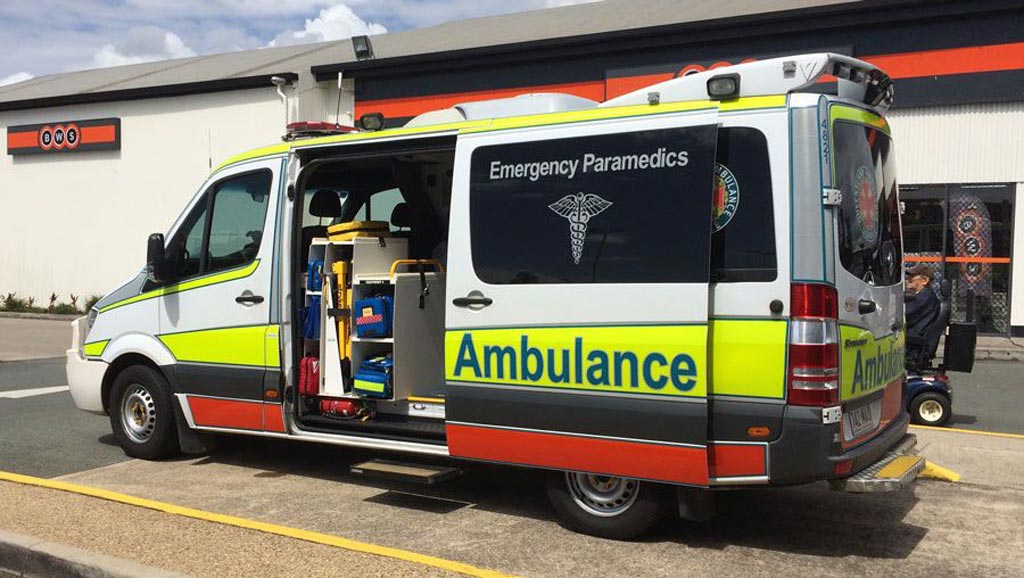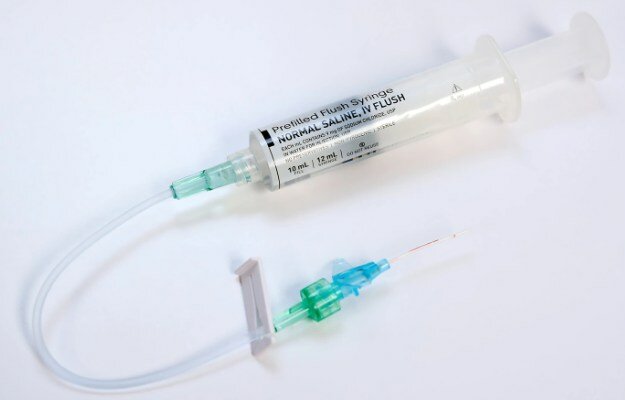Novel Sedative Quickly Tames Violent EMS Patients
|
By HospiMedica International staff writers Posted on 16 May 2018 |

Image: Paramedics in Queensland will soon be armed with droperidol to calm violent patients (Photo courtesy of QAS).
A new sedative can help reduce the escalating violence against paramedics and emergency medical services (EMS), mostly by patients fueled by alcohol and drugs.
Researchers at the University of Queensland (Brisbane, Australia), the Queensland Ambulance Service (QAS; Brisbane, Australia), and other institutions conducted a prospective study of the sedative droperidol for the treatment of prehospital acute behavioral disturbance, compared to the internationally accepted standard, midazolam. In all, 141 patients were administered midazolam and 149 patients were administered droperidol during the study period. The primary outcome was the proportion of adverse effects, with secondary outcomes including time to sedation, requirement for additional sedation, staff and patient injuries, and prehospital time.
The results revealed fewer patient adverse events with droperidol (7%) than with midazolam (23%). The median time to sedation was 22 minutes for droperidol compared to 30 minutes for midazolam, and additional prehospital sedation was required in 4% of the droperidol patients, compared to 14% of the midazolam patients. In addition, 7% of droperidol and 42% of midazolam patients required further sedation in the emergency department (ED). There were no differences in patient or staff injuries, or prehospital time. The study was published in the March 2018 issue of The Journal of Prehospital Emergency Care.
“Our paramedics and emergency department staff welcome the impact droperidol is having and there are some amazing stories of how it quickly it works to calm really aggressive and violent patients,” said Lachlan Parker, ASM, executive manager of clinical policy development at the QAS. “It's also simple to administer, there are much fewer side-effects, it rarely over-sedates and patients wake up much nicer. We're so happy to finally have a safe drug to use.”
“The days of repeated doses of midazolam being given by paramedics are over, it just takes too long to sedate patients using this drug, and it is more dangerous. We're now pushing for paramedics and clinicians to administer the droperidol intramuscularly, and to stop mixing different sedatives,” said lead author toxicologist Colin Page, PhD, of the University of Queensland. “Based on our extensive research, the standard protocol for violent patients should be 10 mg droperidol (65-75% effective) followed by second dose of 10 mg (which is 95% effective), and then ketamine.”
Sedation is the reduction of irritability or agitation by administration of sedative drugs, and is typically used in procedures such as endoscopy, rapid sequence intubation (RSI), minor surgery, and in dentistry for high-anxiety patients. Sedation is also used extensively in the intensive care unit (ICU) so that patients who are being ventilated tolerate having an endotracheal tube in their trachea. Drugs that can be used for sedation include propofol, etomidate, ketamine, fentanyl, midazolam, and droperidol.
Related Links:
University of Queensland
Queensland Ambulance Service
Researchers at the University of Queensland (Brisbane, Australia), the Queensland Ambulance Service (QAS; Brisbane, Australia), and other institutions conducted a prospective study of the sedative droperidol for the treatment of prehospital acute behavioral disturbance, compared to the internationally accepted standard, midazolam. In all, 141 patients were administered midazolam and 149 patients were administered droperidol during the study period. The primary outcome was the proportion of adverse effects, with secondary outcomes including time to sedation, requirement for additional sedation, staff and patient injuries, and prehospital time.
The results revealed fewer patient adverse events with droperidol (7%) than with midazolam (23%). The median time to sedation was 22 minutes for droperidol compared to 30 minutes for midazolam, and additional prehospital sedation was required in 4% of the droperidol patients, compared to 14% of the midazolam patients. In addition, 7% of droperidol and 42% of midazolam patients required further sedation in the emergency department (ED). There were no differences in patient or staff injuries, or prehospital time. The study was published in the March 2018 issue of The Journal of Prehospital Emergency Care.
“Our paramedics and emergency department staff welcome the impact droperidol is having and there are some amazing stories of how it quickly it works to calm really aggressive and violent patients,” said Lachlan Parker, ASM, executive manager of clinical policy development at the QAS. “It's also simple to administer, there are much fewer side-effects, it rarely over-sedates and patients wake up much nicer. We're so happy to finally have a safe drug to use.”
“The days of repeated doses of midazolam being given by paramedics are over, it just takes too long to sedate patients using this drug, and it is more dangerous. We're now pushing for paramedics and clinicians to administer the droperidol intramuscularly, and to stop mixing different sedatives,” said lead author toxicologist Colin Page, PhD, of the University of Queensland. “Based on our extensive research, the standard protocol for violent patients should be 10 mg droperidol (65-75% effective) followed by second dose of 10 mg (which is 95% effective), and then ketamine.”
Sedation is the reduction of irritability or agitation by administration of sedative drugs, and is typically used in procedures such as endoscopy, rapid sequence intubation (RSI), minor surgery, and in dentistry for high-anxiety patients. Sedation is also used extensively in the intensive care unit (ICU) so that patients who are being ventilated tolerate having an endotracheal tube in their trachea. Drugs that can be used for sedation include propofol, etomidate, ketamine, fentanyl, midazolam, and droperidol.
Related Links:
University of Queensland
Queensland Ambulance Service
Latest Critical Care News
- CPR Guidelines Updated for Pediatric and Neonatal Emergency Care and Resuscitation
- Ingestible Capsule Monitors Intestinal Inflammation
- Wireless Implantable Sensor Enables Continuous Endoleak Monitoring
- Pulse Oximeter Index Offers Non-Invasive Guides for Fluid Therapy
- Wearable Patch for Early Skin Cancer Detection to Reduce Unnecessary Biopsies
- 'Universal' Kidney to Match Any Blood Type
- Light-Based Technology to Measure Brain Blood Flow Could Diagnose Stroke and TBI
- AI Heart Attack Risk Assessment Tool Outperforms Existing Methods
- Smartphone Imaging System Enables Early Oral Cancer Detection
- Swallowable Pill-Sized Bioprinter Treats GI Tract Injuries

- Personalized Brain “Pacemakers” Could Help Patients with Hard-To-Treat Epilepsy
- Microscopic DNA Flower Robots to Enable Precision Medicine Delivery
- Origami Robots to Deliver Medicine Less Invasively and More Effectively
- Improved Cough-Detection Technology Aids Health Monitoring
- AI Identifies Children in ER Likely to Develop Sepsis Within 48 Hours
- New Radiofrequency Therapy Slows Glioblastoma Growth
Channels
Surgical Techniques
view channel
Robotic Assistant Delivers Ultra-Precision Injections with Rapid Setup Times
Age-related macular degeneration (AMD) is a leading cause of blindness worldwide, affecting nearly 200 million people, a figure expected to rise to 280 million by 2040. Current treatment involves doctors... Read more
Minimally Invasive Endoscopic Surgery Improves Severe Stroke Outcomes
Intracerebral hemorrhage, a type of stroke caused by bleeding deep within the brain, remains one of the most challenging neurological emergencies to treat. Accounting for about 15% of all strokes, it carries... Read morePatient Care
view channel
Revolutionary Automatic IV-Line Flushing Device to Enhance Infusion Care
More than 80% of in-hospital patients receive intravenous (IV) therapy. Every dose of IV medicine delivered in a small volume (<250 mL) infusion bag should be followed by subsequent flushing to ensure... Read more
VR Training Tool Combats Contamination of Portable Medical Equipment
Healthcare-associated infections (HAIs) impact one in every 31 patients, cause nearly 100,000 deaths each year, and cost USD 28.4 billion in direct medical expenses. Notably, up to 75% of these infections... Read more
Portable Biosensor Platform to Reduce Hospital-Acquired Infections
Approximately 4 million patients in the European Union acquire healthcare-associated infections (HAIs) or nosocomial infections each year, with around 37,000 deaths directly resulting from these infections,... Read moreFirst-Of-Its-Kind Portable Germicidal Light Technology Disinfects High-Touch Clinical Surfaces in Seconds
Reducing healthcare-acquired infections (HAIs) remains a pressing issue within global healthcare systems. In the United States alone, 1.7 million patients contract HAIs annually, leading to approximately... Read moreHealth IT
view channel
Printable Molecule-Selective Nanoparticles Enable Mass Production of Wearable Biosensors
The future of medicine is likely to focus on the personalization of healthcare—understanding exactly what an individual requires and delivering the appropriate combination of nutrients, metabolites, and... Read moreBusiness
view channel
Philips and Masimo Partner to Advance Patient Monitoring Measurement Technologies
Royal Philips (Amsterdam, Netherlands) and Masimo (Irvine, California, USA) have renewed their multi-year strategic collaboration, combining Philips’ expertise in patient monitoring with Masimo’s noninvasive... Read more
B. Braun Acquires Digital Microsurgery Company True Digital Surgery
The high-end microsurgery market in neurosurgery, spine, and ENT is undergoing a significant transformation. Traditional analog microscopes are giving way to digital exoscopes, which provide improved visualization,... Read more
CMEF 2025 to Promote Holistic and High-Quality Development of Medical and Health Industry
The 92nd China International Medical Equipment Fair (CMEF 2025) Autumn Exhibition is scheduled to be held from September 26 to 29 at the China Import and Export Fair Complex (Canton Fair Complex) in Guangzhou.... Read more














